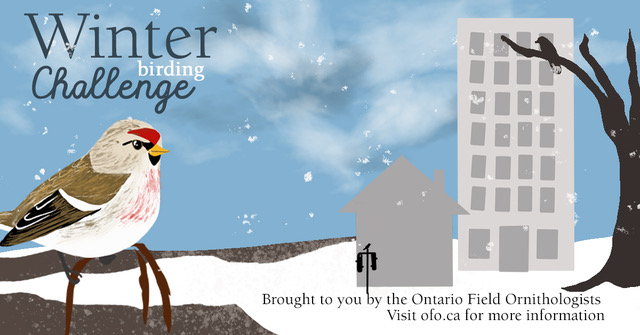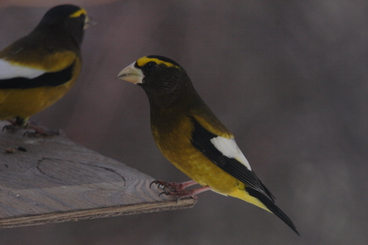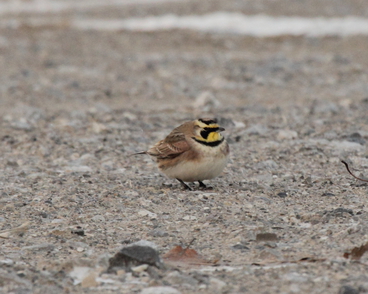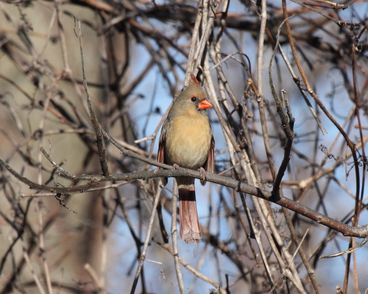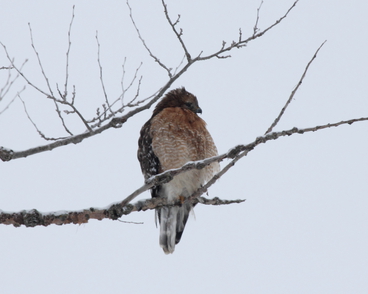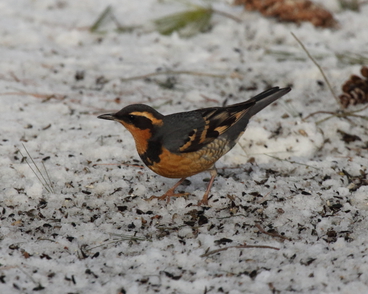Winter birding tips
Winter birding brings with it its own set of challenges (and rewards!), below are some tips to maximize your winter birding experience.
Bird ethically
Winter is a challenging time for many birds, so keep in mind that even your presence can be stressful to some birds. Always follow the OFO code of ethics when out birding. Remember, the bird's well-being always comes first.
Be patient
There are fewer birds during the winter than any other time of the year in Ontario. The woods can feel very quiet for long stretches of time. Birds tend to be even more clumped in time and space at this time of year so don't get discouraged -- the next flock might be just around the corner!
Do your research
Winter is the time of year when day-to-day movement for most species is limited, so if a bird is spotted at a specific location one day, it's likely to be there the next. Check eBird Canada for recent sightings.
Water
You're going to have a hard time finding ducks and other water birds if you don't first find the water. Winter is the peak duck-watching season along the Great Lakes. For a significant boost in species, head to the shores of Lake Ontario or Lake Erie or, while they're open, other large bodies of water. A spotting scope is very helpful when birding large water bodies.
Even small amounts of open water can attract birds. There are often lingering species associated with creeks and seeps. As an example, Wilson's Snipes have overwintered in Marathon at a small seep for several winters, so any feature like this, no matter how small, should be checked for lingering birds. Rails are another possibility, but most likely at these features are lingering songbirds. Even in winter, there are often emerging insects associated with open water for insectivores.
Food
Finding areas with abundant food is very important. In particular, look for places with abundant berry crops; a wide variety of songbirds depend on fruit through the winter. Waxwings and American Robins are the most obvious, but many other species can also be found in these areas, especially when combined with water and heavy cover. Be sure to look through any flocks you might find for less common species.
Similarly, trees with abundant seed crops can be magnets for birds. Redpolls love birch and alders, many other finches focus on conifers, and ash and maples can also attract finches such as Purple Finches and Evening Grosbeaks. Weedy, overgrown fields and ditches can be goldmines for sparrows and finches too.
Heavy cover
Birds need to feel safe and having heavy cover to retreat to for roosting is important for many species. Combining heavy cover with water and/or food is a good recipe for finding interesting species. A wide variety of birds may use heavy cover for roosting including Wild Turkeys, hawks, owls, and songbirds.
Sheltered areas
Focusing on areas that are out of the wind can often be productive. Remember, birds need to stay warm too. Birds (think owls especially) will often roost on the leeward side of woodlots or even the trunks of trees. Combining this with early or late sun is a surefire way to find "sun-bathing" birds, especially on very cold mornings.
Focus on chickadees...and don't forget to pish!
Songbirds are often in small flocks during the winter and chickadees are often the core of the flock here in Ontario. Listen for chickadees, they will lead you to other species. When you encounter a flock, pay attention to the edges of the flock as that is often where the more interesting species are lurking. Where permitted, the frequent use of "pishing" is an important technique for attracting the flocks in close enough to see. Squeaking is also effective and whistled imitations of Eastern Screech-Owl and Northern Saw-whet Owl calls can also solicit responses from songbird flocks. If you hear a commotion of chickadees or Blue Jays, follow it, there's a chance they have spotted a predator such as a roosting hawk or owl.
Microclimates
Areas with a slightly warmer microclimate can be attractive to lingering species. Warm-water outflows from industry are one of the more well-known types of areas to focus on but cities in general have "hot spots" that for whatever reason create slightly warmer microclimates that may concentrate lingering birds. Seek these out and check them regularly.
Wear the right gear
Dressing for winter birding is really challenging. You will likely spend large amounts of time standing very still followed by bouts of walking. Layering is very important and wearing wind-proof clothing is also very helpful. Be aware that birding near open water in winter can result in higher wind chills; Niagara Falls can feel bitterly cold even when the temperature is above zero. Also consider the noise your clothing makes when moving; choosing something that makes less noise can help with finding birds and not flushing them early. Many birders use chemical heat packs to help keep their toes and fingers warm and more and more winter gear is now available with rechargeable battery-powered heaters built right in.
Binocular considerations
Binoculars can become more difficult to use in very cold temperatures -- the focus wheel in particular can become stiff. To make things worse, loose-fitting gloves or mitts can make using binoculars very difficult in winter. Be prepared for this and consider tight-fitting gloves, especially if your focus wheel tends to become stiff in cold weather. Getting in and out of a vehicle while winter birding can also cause binoculars to fog up; consider applying an anti-fog coating (check with your binocular manufacturer first) and bring lots of lens cleaners/wipes.
Camera considerations
The primary concern with cold temperatures for digital cameras is that the battery life can become quite reduced. Consider bringing an extra battery with you and keeping it warm, such as in an interior pocket close to your body. Similar to binoculars, fogging can be an issue.
Car birding
Birding by car is a favourite pastime of many Ontario birders. It can be quite rewarding, especially for open-country hawks and owls, but brings with it its own sets of challenges. Below are some tips to help maximize your birding experience.
Winter window shimmer
On very cold winter days, if you open the window of your car and try to look with binoculars or your camera, there can be considerable heat distortion. One way to minimize this is to open the window on the opposite side of the car too.
Focus on leeward side of woodlots
Particularly when searching for hawks, many birds will concentrate on the leeward side of woodlots or other shelter to stay out of the wind. This is especially true early and late in the day when it coincides with the sunny side.
Fresh snow can concentrate birds
During or right after a heavy snow, many birds will be concentrated along roadsides, especially after a plow passes by. Plows scrape off the snow and expose gravel and food.
Manure
When looking for Snow Buntings, Horned Larks, and Lapland Longspurs, they'll often concentrate in farm fields right after manure has been applied. The manure can contain undigested seeds but also helps melt the snow. Never drive by a freshly-manured field without stopping!
Keep your windows clean
The salty spray from the road can really make it difficult to see out your windows. In addition, if you're driving through large open areas with snow blowing perpendicular to the road, your windows will quickly get covered in snow/moisture. Having a squeegee and a spray bottle (just water works fine unless it is very cold, in which case some washer fluid helps) will help keep your windows clear for viewing. Some birders also use anti fog coatings on vehicle windows.
Window mounts
Using your vehicle as a blind helps you get closer to birds, but also can keep you warm. Many manufacturers sell window mounts for spotting scopes and cameras which work really well in the winter. A large bean bag draped over the open window can also work well.
Winter safety
Winter tires are pretty much a necessity, especially when venturing out of urban areas. A winter safety kit is an important feature when birding by car in the winter. On top of traditional safety items a warm blanket, candles and matches, and a snow shovel are useful things to include. Also be aware that gas stations may close earlier in some small towns at this time of year. Many areas have poor cell coverage and telling someone your travel plans is an important safety measure in these areas.
No winter maintenance roads
Be aware that many rural parts of the province have roads that are not maintained during the winter. These will all be marked with a sign advising of this. Be very careful on these roads as conditions can deteriorate very quickly. If you do venture down one, be prepared to back out a long distance should you come to an impassable stretch. Most tow trucks will not come down these roads, so if you get stuck, you're in big trouble.

